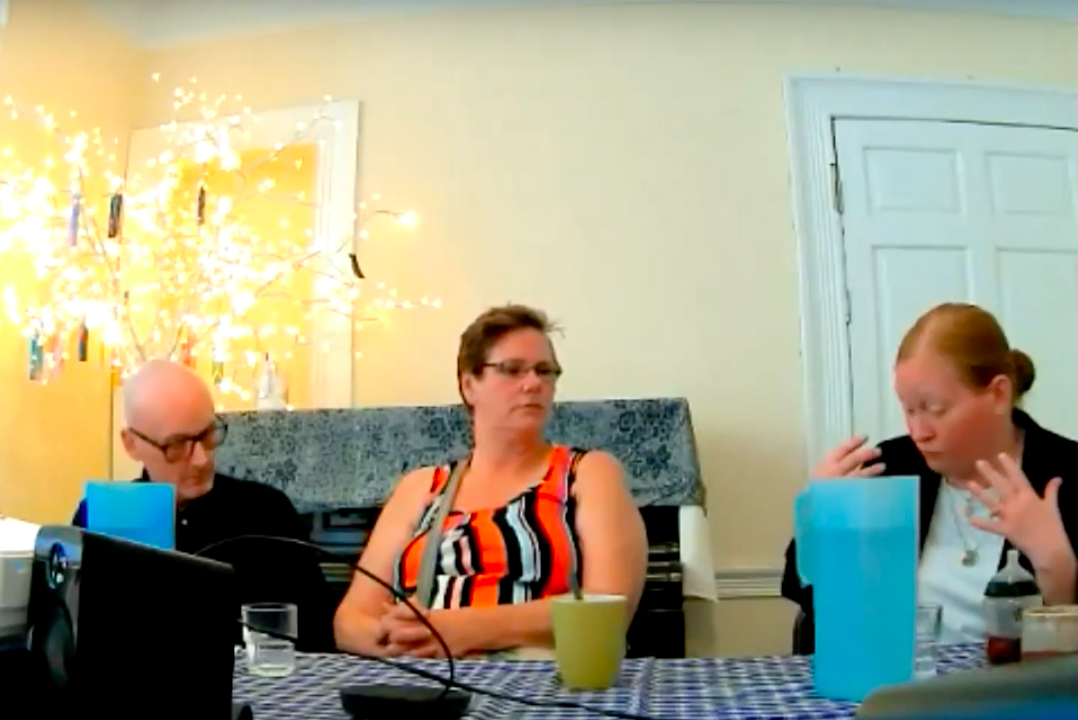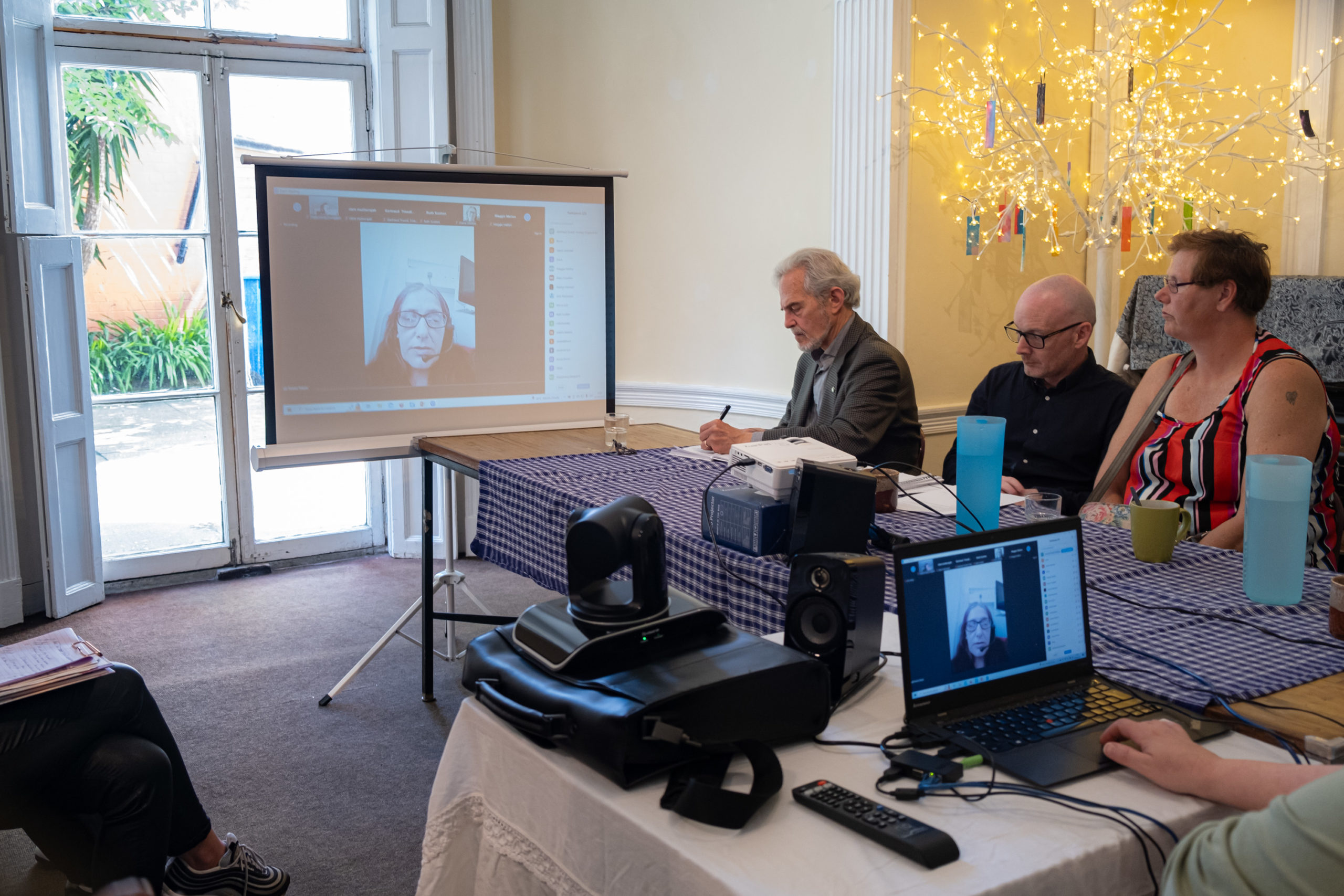A seminar to celebrate progress in parent advocacy

On 6 June, ATD Fourth World co-hosted a hybrid in-person/virtual seminar with PFAN (the Parents Families and Allies Network) to speak about how participation by peer-to-peer advocates can improve children’s and family services. The featured guest speaker was Dr. David Tobis, a sociologist and international leader in the fight for child welfare systems to respect the rights and meet the needs of parents and their families.
The panel also included peer-to-peer parent advocates Nikki Hewson, Tammy C., and PFAN co-chair Tammy Mayes. Dr. Simon Haworth of the University of Birmingham facilitated the event which was attended by about seventy online participants and twenty at Addington Square, ATD’s London hub.
Learning from the journey in New York
David opened the floor with a presentation of his work in New York City which has enabled parents with children in the child welfare system to have a voice. First, he painted a stark picture of the pre-1990 conditions there, a time before parents’ voices were heard and when systemic respect for parental rights was lacking.
- There were twenty class action lawsuits against the city and foster care agencies.
- Children were removed because poverty was confused with neglect.
- Almost 50,000 children were in foster care.
- Children were in care for an average of four years and waiting seven years to be adopted.
- 40% of indicated cases of abuse/neglect got no help.
To make change, David alongside a friend created the Child Welfare Fund, which raised money to help parents play a role in policy development and in helping other parents. They operated the Child Welfare Fund based upon the belief that
people have the right to participate in the decisions that affect their lives.
A strategy for parent advocacy was developed. Parents who had been investigated by protective services, some of whom had their child removed, participated in a three-month training programme divided into three parts.
- Classroom training: learning how to be an advocate, garnering an understanding of the laws and policies of the child welfare system, and also learning how to write and tell their own stories.
- Experiential training: parents worked in child welfare agencies under the supervision of a parent advocate and a social worker.
- The final part of the training was parent support groups where parents got together without social workers and discussed their problems and experiences to figure out ways to move forward.
Once trained, parents were hired and paid by child welfare agencies.
Overcoming resistance
John Mattingly was the commissioner (the person who runs the child welfare system in New York) for seven years and he strongly supported parent advocates. He said:
“Everywhere you look in the city, where we are doing our best work, where the best is happening, you find parent advocates around.”
There was initially resistance. The social work community felt afraid that the parent advocates might second-guess them, violate confidentiality, or re-experience their own trauma. Yet research by Marina Lalayants* showed that parents and social workers both felt better when parent advocates were present.
Several approaches were used to change how people saw parents who have been involved with child welfare. For example, Rise Magazine was founded and led by parents “impacted by the family policing system” of social services. Rise believes
“that parents have the answers for their families and communities. Our mission is to empower parents to be leaders and to create communities that invest in families and offer collective care, healing and support.”
Another effort to shift the narrative was ceremonies to present cash awards to:
- mothers and fathers who worked hard to have their children reunited with them;
- young people in foster care who helped others;
- and social workers who worked above and beyond to help parents reunite with their children.
All of this created the conditions for social workers to begin appreciating the expertise of parents rather than seeing them as mere “clients”. It has been theorised that contact reduces prejudice.
Proof in numbers and Maori inspiration
New York City’s government additionally implemented interdisciplinary legal teams, which were composed of a lawyer specially trained in child welfare, a social worker, and a parent advocate.
The results proved this to be beneficial. In 1992, almost 50,000 children in New York City were in foster care. A child was taken from their family every 45 minutes.
Now twenty years later, the number of children in foster care there has dropped to 7,000.
David explained that this parent advocacy in New York was inspired by a cultural practice among the Maori, who have a history of family group conferences. When a family is at risk, members of the community and extended family get together to figure out how a child can remain safely at home and what kinds of support are available. If a child does have to be removed the family group conference looks for a member of the community to host the child as opposed to strangers.
This model of family group conferencing was enshrined in law in New Zealand in 1989. The concept then spread to other countries. Today there are now 100 peer-to-peer support programmes in high-income countries, including Australia, Canada, Finland, Norway and in all four nations of the UK.
David concluded by saying that in the UK there are now about ten local authorities with trained parent advocates working alongside social workers. Here we also have PFAN, which organises parent-led training and webinars. PFAN also campaigns to improve the system and creates regular dialogue between parents and professionals.
Views from peer-to-peer parent advocates
Both Nikki and Tammy C. have trained with local authorities in England to be parent-to-parent advocates. Nikki said:
“I had a social worker who saw something in me. She believed in me, she said to me, ‘Do you want to be a parent advocate?’ and I said, ‘Yes 100%.’”

Prior to this, when Nikki was first interacting with social services, there was a professional advocate assigned to her; however confidentiality was broken and she found this a very negative experience. Having experienced herself what it was like to go through the process alone, she wanted to become a parent advocate to do things in a more trusting way and to be a voice for others, particularly those experiencing domestic violence.
Simon asked Nikki: “What is important about parent advocacy to you and how do you think it differs from a professional advocate?” She responded: “because we have been through the system ourselves.” She therefore has a wide understanding of the emotions and concerns of the parents and can react with true sensitivity.
“Social workers lack time”
Nikki emphasised the importance of spending time with parents. They are sometimes offered parenting courses, but these can be 12 weeks which is quite a limiting time frame in terms of making profound change. Parent advocates can offer time, care and patience. This consistency can be life-altering for other parents.
Tammy C. shared the steps she takes and the significance of relationship-building with the other parents she supports:
“I will get to know them first, I don’t go by the report. The next time I speak to them I will ask them: ‘What do you want me to do? How can I help you? Whatever we talk about is between me and you, except for safeguarding issues.’ You can go with parents for a coffee, take them to a place like the park and make them feel comfortable.”
The thoughtfulness parent advocates provide allows parents to be themselves and feel less judged. Taking them out of their home, outside of what they would sometimes deem as a professional zone allows the relationship to grow stronger. In turn parents can open up about their dilemmas and try to resolve them for their children, themselves and their family as a unit. (To read a profile of Tammy talking about her role as a parent advocate, please click here.)
Celebrating small steps
Tammy shed light on mental health and everyone’s different life circumstances: “You’ve got to be mindful of the parents.” Parents want to do their best for their children; but life can be difficult, which a parent advocate can recognise. Tammy explained further: “As parent advocates, we can help social workers by giving them feedback.”

There is no doubt that being a parent advocate can come with challenges. They may get asked for help outside of their realm; however, they are able to signpost parents to the relevant services. Other challenges can be addressed collaboratively, which is why a supportive local authority is key in this process. In comparing their relationships with the local authorities that they were parent advocates for, Nikki and Tammy agreed that it is paramount to be part of a team that assists and champions them.
Tammy Mayes concluded with thoughts for the future. “We need people that are committed to this work. It is about the small steps, celebrating what we have done, talking about the negatives so we can learn from it and move on from it. At the end of the day everyone is a human being and we need to build relationships.”
Q & A
As the discussion drew to a close audience members raised questions and also shared information. Susie Devins spoke about a new report by the International Movement ATD Fourth World, “Building a Future Without Poverty for Children: Parents and Society Together”.
Based mainly on participatory work by 50 parents experiencing poverty from seven European countries, that report, which includes proposals for improving child protection systems, can be found here.
Social worker Jody Torode sparked conversation about the lack of financial resources within the system and where to find funding to pay parent advocates for their work. David stressed that parent advocates should not work for free. As experts-by-experience, their time is just as valuable as that of other professionals who are being paid. To find the funding, he pointed out that when you reduce the number of children in care, a lot of money can be economised. In New York, there was an agreement that when money was saved, some of it should go to supporting parent-to-parent advocacy.
New York’s transformation of the child welfare system is a great example of how parent advocacy drives ripples of positive change. On a professional level, it opens the door for notable expertise to enhance understanding and improve mechanisms to move individuals and families forward. From the system’s perspective, money is saved.
And most importantly from the families’ perspective, parent advocacy provides valuable insight and much needed support to navigate a system where the odds have long been stacked against them.
For David’s powerpoint presentation click here: 2024-06-Tobis_PowerPoint
___

